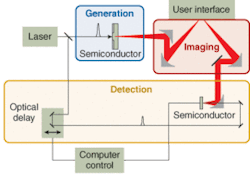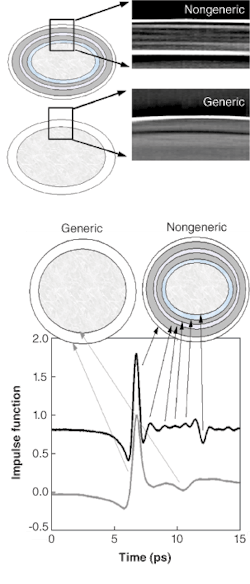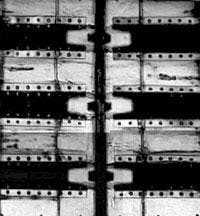An underused part of the spectrum offers new imaging and spectroscopic abilities for nonstructive testing and quality control.
Quality control on the factory floor-and the closely related activity of nondestructive testing-has long used visible imaging systems. Some applications also use infrared, ultraviolet, or x-ray wavelengths. Now, systems operating at wavelengths on the edge of IR and microwaves (about 30 µm and 1 mm)-at terahertz frequencies-are providing information that isn’t available in other parts of the spectrum. Researchers are actively developing new methods and finding applications, and at least two firms are selling terahertz-imaging systems for quality control (QC) and nondestructive testing.
Terahertz benefits
Pulsed terahertz systems can provide three-dimensional (3-D) images and spectroscopic information and terahertz radiation can penetrate some materials that are opaque to the human eye. Because of these abilities, terahertz imaging has significant potential for security applications (like identifications of plastic explosives) as well as for commercial applications in situations in which other sensors cannot provide enough information-and in which that information can save a manufacturer a lot of money (see Fig. 1).
At these longer wavelengths, the lateral resolution of images is not as fine as it is at visible wavelengths. It’s similar to that of the human eye, according to Robin Risser, CEO of Picometrix (Ann Arbor, MI)-about 100 to 200 µm. However, “depth resolution is 8 to 10 µm,” explains Don Arnone, president of TeraView (Cambridge, England), because the technique for imaging depth (time-of-flight) is different from lateral imaging. And many organic molecules display strong and distinctive absorption and dispersion (due to rotational and vibrational transitions) when exposed to subpicosecond terahertz pulses.
“The two show-stoppers for terahertz,” says Risser, “are water and a reasonable thickness of metal-although foil-coated Mylar films can be imaged through.” Because water absorbs this radiation and metal reflects it, terahertz imagers cannot see through these materials. Water and metal, however, can be used to advantage in some situations. Terahertz imaging can measure the moisture content of items inside plastic packaging, and a metal substrate below an item of interest can be used as a mirror to return more radiation to the sensor.
System basics
One reason this region of the spectrum has not been extensively explored until recently is that radiation sources were lacking. Techniques for directing and detecting the terahertz radiation come from the optical and radio-frequency fields. Two commercialized broadband pulsed systems use basically the same method: a near-IR femtosecond laser pulse hits an electrically biased electro-optic semiconductor, thus accelerating holes and carriers, which emit terahertz radiation. An antenna on the surface of the semiconductor couples the terahertz pulse out of the semiconductor (see Fig. 2).
FIGURE 2. An ultrashort laser pulse generates a freely propagating terahertz pulse by photoexciting a highly biased electro-optic semiconductor. Each laser pulse creates many charge carriers in a region with a high electric field. As the carriers accelerate, they give off a burst of radiation at terahertz frequencies. The pulse is coupled out of the semiconductor by an antenna, shaped, and guided by terahertz optics, interacts with the sample (at the user interface), then is refocused onto an antenna and into another semiconductor for detection.
The specifics of efficient terahertz generation, sensitive detection, and optimal results interpretation are a matter of patents and proprietary information for the companies involved in this area.
The pulse illuminates the sample, and some energy is absorbed, reflected, or transmitted. The wave is detected with another antenna atop another semiconductor. The radiation induces a transient bias of the receiver. By photoexciting the receiver with a time-delayed pulse from the laser, the electric field of the incident terahertz pulse can be sampled with subpicosecond resolution, producing either optical or electrical output. “Effectively,” says Risser, “the receiver is a sampling terahertz oscilloscope.”
The detected waveform, with time-of-flight information, can provide the location of the surface and interfaces within a sample, as well as information about the dielectric constants. Consider, for example, a gas bubble embedded within a solid. The dielectric constants of the gas and solid differ, and therefore the speed of propagation of the terahertz waves differs in the materials. So if a wave doesn’t reach the detector at the time expected for a homogeneous solid, one can guess that the wave encountered a different material within the ceramic.
Furthermore, the Fourier transform (FT) of the returned pulse can provide frequency information that shows which frequencies are absorbed, thereby allowing spectroscopic fingerprinting of chemicals in the sample. The FT may be able to identify the gas in the example above using terahertz time-domain spectroscopy.
For quality-control applications, the imaging needs to happen quickly, which requires power and wide bandwidth. “If you don’t have sufficient bandwidth, you don’t get enough information,” explains Arnone.
Testing tablets
One early terahertz application is quality control of drug tablets. Even for homogeneous tablets (as opposed to time-release or coated tablets), manufacturers need to know whether enough of the active ingredient is in a specific tablet and that it is evenly distributed. Current testing regimes for tablets tend to be destructive-a few tablets from a batch are removed, and may be subjected to IR imaging before destructive testing, such as cutting and dissolving the tablet. “The beauty of terahertz imaging,” Arnone says, “is that is provides a 3-D chemical and structural map of a tablet in a nondestructive way.”
Arnone’s company has developed a specific product, the TPI Tablet Imager, for the pharmaceutical industry. The terahertz imager can scan a tablet, providing several point measurements showing the distribution and concentration of the active ingredient through the tablet (see Fig. 3). This method could provide nondestructive batch testing-potentially through the packaging plastic. The company is developing libraries of good and bad tablets.
FIGURE 4. Micrographs show layers of coatings on a nongeneric and generic tablet. Taking micrographs requires destroying the tablet, but the terahertz wave shows the structure nondestructively.
In addition to providing a means to scan the bulk properties of a tablet, TeraView has also been working on ways to image coatings (see Fig. 4). “Many new tablets have complex coatings or other structures in them that are difficult to probe with other techniques,” says Arnone. “Terahertz potentially provides a solution to these issues.” The FDA is very interested in the coating work. The company has measured coatings as thin as 5 µm. Imaging coatings may be one method of detecting counterfeit tablets.
Tablets and pills are only one example of mixtures that could benefit from a method that provides real-time quality control. Risser suggests that terahertz imaging could be used to examine many other mixtures, including chemicals mixed with a base carrier, metal flakes in paint, or tears in paper products-in paper mills, one of the biggest problems is paper tearing. It’s possible that the water absorption of terahertz radiation could be used to identify potential tears before they occur if tears occur where the paper contains more moisture.
Space shuttle
One high-visibility terahertz quality-control application for Picometrix involves imaging the spray-on insulation of NASA’s space shuttle. The Columbia disaster was caused by a piece of sprayed-on foam insulation on the outside of the fuel tank that broke away during lift-off and damaged a heat-shielding tile. Upon re-entry, the tile failed, causing destruction of the Shuttle.
The insulation is needed around the external fuel tank to keep the liquid nitrogen and liquid oxygen cold on the launchpad, and to prevent ice buildup on the outside of the tank. The tank (150 ft tall × 27 ft in diameter) is covered with up to a foot deep of superlight foam insulation, sprayed on in layers. As part of the effort to get the space shuttles safe to fly again, the quality of the foam insulation is being tested as the layers are applied. After the disaster, says Risser, NASA’s nondestructive testing (NDT) group in Langley, VA, approached Picometrix about imaging voids in the foam insulation.
FIGURE 5. Terahertz images of foam insulation (light areas) on the external fuel tank of the space shuttle. Voids within and delamination between layers of foam insulation appear as dark areas. This composite image shows 25 defects, only two of which are visible on the exterior of the foam.
The company’s QA-1000 industrial quality-control system was used to look for voids in the insulation (see Fig. 5). One of the challenges of this system is raster-scanning such a big object and having the sensors located about 30 m away from the lasers. The system uses patented fiber-coupling technology to get the laser beam focused on the terahertz-generating semiconductor.
What’s next?
Many industries have unmet quality-control needs to which terahertz technology could be applied-but only if it is economically feasible. A major limiting factor of the current technology is the cost of a turnkey system, which ranges from $200,000 to $400,000.
The cost of the systems is expected to drop as more units are sold, but one of the challenges remains to find customers who can save substantial amounts of money by using the equipment for routine quality control, and possibly for NDT during product development.
Risser explains that the main market for terahertz technology today is in applications with no existing alternatives, or where existing NDT technology has very high operating expenses.
Much of the cost is associated with the ultrafast laser, says Arnone. If a less expensive, but still efficient, method of generating terahertz pulses is developed, the economics of the technology will improve. For groups that already own a femtosecond laser, Picometrix sells a cheaper version of its T-Ray 2000 for lab use without the laser, but the system is different from the ruggedized turnkey system sold for industrial applications.
Another challenge is in guiding terahertz radiation. To some extent Picometrix’s fiber-coupled system circumvents the difficulty, and optics exist for manipulating the radiation in free-space, but more applications would be available if the systems did not require line-of-sight for imaging. Finding materials for waveguides is challenging because the most transparent materials tend to be crystalline (and therefore not flexible), while more flexible materials such as plastics and glasses have much higher absorption of these wavelengths. Furthermore, because the shape of the wave is of vital importance for many applications, the waveguide must be made of a material with low dispersion and distortion.
Researchers have demonstrated waveguiding with metal tubes, plastic ribbons, dielectric fibers, and photonic crystals designed for terahertz frequencies. Two promising approaches involve waveguiding using parallel metal plates, including work by Daniel Grischkowsky and others at Oklahoma State University (Stillwater); and a bare wire, including work by Daniel Mittleman at Rice University (Houston, TX).
FURTHER READING
List (with links) of academic groups and companies engaged in terahertz time-domain spectrometry: www-ece.rice.edu/~daniel/groups.html




